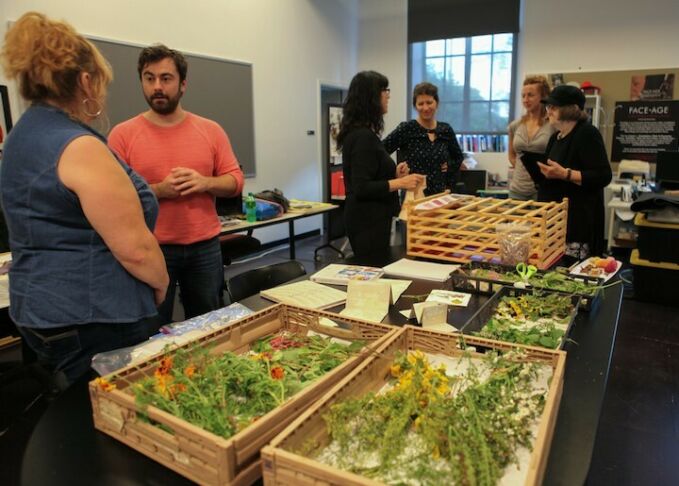October 01, 2019
The materiality of color: art historians return to the source

Before paint stores and computer screens flooded the visual environment with a seemingly infinite variety of hues, color was a hard-earned thing. Pigments had to be harvested from animals, dug from mines thousands of miles away, or generated through obscure and often toxic alchemical processes. Entwined with histories of politics, economics, geology, geography, color offers an extraordinary opportunity to explore art's long history of interdisciplinary engagement. That is why Sarah Rich and Daniel Zolli, professors in the Penn State Department of Art History and embedded researchers in the Arts & Design Research Incubator, are taking color back to its materiality through research, teaching, and an upcoming symposium.
"Bugs, Boulders, Beakers: The Materiality of Artists' Colors," a conference organized by Rich and Zolli, will be held at Penn State on October 5-6 in the Palmer Lipcon Auditorium in the Palmer Museum of Art. In conjunction with the conference, they are also hosting a pigment workshop for registered participants in the ADRI. Bringing together a wide range of international scholars, the conference will engage artists, scholars, and scientists in discussions about history, methodologies, and artmaking.
"Understanding color as a physical substance deepens our appreciation for colored artifacts and the artists who make them," said Associate Professor of Art History, Sarah Rich, whose recent graduate seminar on color has enhanced the department's increasing interest in materiality studies. Rich's current research focuses in part on the toxicity of pigments‚ an issue that artists deal with frequently. Cobalt, for example, provides painters with a beautiful blue, but it can be poisonous. During the Cold War, cobalt's poisonous features were amplified through terrifying new technologies: when converted into a radioactive isotope, cobalt became a tool of nuclear war as well as a method of cancer treatment. Her paper for the symposium will explore the extent to which artists using cobalt pigments in the 1960s and 1970s might have purposely engaged with such connotations.
Daniel Zolli, who is in his second year as assistant professor of Art History at Penn State, is currently working on a book manuscript on the early Renaissance sculptor Donatello and his obsessive experimentation with materials and techniques. At the symposium, Zolli will be presenting an aspect of that work, on Donatello's habit of disguising his materials: of making cheap sculptural materials look like other, more expensive ones, often with paint. Zolli's research explores the broader cultural climate in mercantile Florence that would have inspired Donatello to do this, leading him to practices like counterfeiting, adulteration, and even cosmetics.
"In many cases," Zolli shared, "Donatello's patrons and viewers were merchants. The reputations, and professional livelihood, of these people depended on not being cheated or deceived. Because of this, merchants, and the artisans with whom they worked had very refined ways to spot when an item‚ say, a dyed wool garment or an ounce of vermilion pigment‚ was made cheaply, or dishonestly, often using their eyesight alone. By 'making up' his materials, then, Donatello was playing a game with his viewers. It's no wonder, when we read popular accounts of Donatello, that he's called cunning, a trickster, and a cheat. But to appreciate this about him, we have to train ourselves to think, and to see, like a fifteenth-century maker."
Rich and Zolli are also co-teaching a course about color, "Color & Culture: Art Historical, Philosophical and Technical Approaches to Hue." Their enrollment not only comprises art history students‚ both undergraduate and graduate‚ but also includes students interested in visual arts, business, materials science, and liberal arts disciplines. Although Rich and Zolli specialize in different time periods, they are excited to stretch the boundaries of their discipline and research by grappling with the science of art and including students in experiential learning.
"This isn't your typical art history class!" noted Zolli. "We're interested in historical questions, of course, but we want to acquaint our students, and ourselves, with the deep reservoirs of material and technical know-how that goes into making art, much of which can't be captured in reading assignments. Grinding insects to make carmine, fermenting leaves to make indigo, feeds a different awareness about the things we study. It invites humility and empathy."
"My favorite example of that," added Rich, "involves ochre. Recent publications have argued that the pigment red ochre may have functioned as a mosquito repellent in malaria-prone areas of Africa in the Middle Stone Age. For part of our ochre lesson I brought in some samples that I'd dug up with a geologist in central PA; we encouraged students to get a sense of ochre's color but also to get a sense of how it would feel on the skin. This was messy! As one of our students was washing up in the bathroom, in walked Dean Korner, who puzzled over this art historian who was covered up to the elbows in earthy pigment. Approaching the scene with her typical sense of curiosity and amusement, the Dean got to talk to the student about what happened in class, which gave the student a chance to share what she'd learned. A gritty experimentation with materials can thus be wonderfully disruptive and adventurous. It provokes new conversations with new interlocutors. It also equips art historians with a kind of practical knowledge that can lead to new questions and methodologies. That's what we're after."
This event is made possible by the generous support of the College of Arts and Architecture, the Arts & Design Research Incubator, and the Diane and Charles King Faculty Enrichment Fund. For more information about the conference and to register, visit the website: http://sites.psu.edu/materialityofcolor/.
